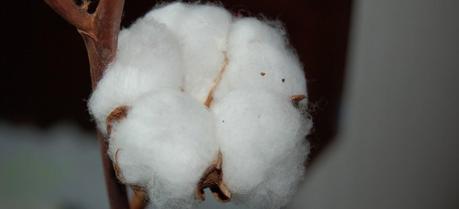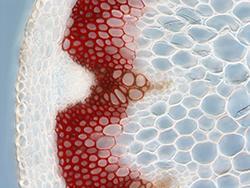 Cotton fibres represent the purest natural form of cellulose, containing more than 90% of this polysaccharide.
Cotton fibres represent the purest natural form of cellulose, containing more than 90% of this polysaccharide.An international collaboration of plant scientists identified a new gene in the biosynthetic pathway of lignin, a major component of plant secondary cell walls that limits the conversion of biomass to energy. These findings published online in this week’s issue of Science Express pave the way for new initiatives supporting a bio-based economy.

The presence of lignin in secondary plant cell walls can be visualised by specific dyes. On this cross section of the Arabidopsis stem, lignin is stained red. (Credit: VIB)
“This exciting, fundamental discovery provides an alternative pathway for altering lignin in plants and has the potential to greatly increase the efficiency of energy crop conversion for biofuels,” said Sally M. Benson, director of Stanford University’s Global Climate and Energy Project. “We have been so pleased to support this team of world leaders in lignin research and to see the highly successful outcome of these projects.”
A plant cell wall mainly consists of lignin and sugar molecules such as cellulose. Cellulose can be converted to glucose which can then be used in a classical fermentation process to produce alcohol, similar to beer or wine making. Lignin is a kind of cement that embeds the sugar molecules and thereby gives firmness to plants. Thanks to lignin, even very tall plants can maintain their upright stature. Unfortunately, lignin severely reduces the accessibility of sugar molecules for biofuel production. The lignin cement has to be removed via an energy-consuming and environmentally unfriendly process. Plants with a lower amount of lignin or with lignin that is easier to break down can be a real benefit for biofuel and bioplastics production. The same holds true for the paper industry that uses the cellulose fibers to produce paper.
For many years researchers have been studying the lignin biosynthetic pathway in plants. Increasing insight into this process can lead to new strategies to improve the accessibility of the cellulose molecules. Using the model plant Arabidopsis thaliana, an international research collaboration between VIB (Flanders Institute for Biotechnology) and Ghent University (Belgium), the University of Dundee (UK), the James Hutton Institute (UK) and the University of Wisconsin (USA) has now identified a new enzyme in the lignin biosynthetic pathway. This enzyme, caffeoyl shikimate esterase (CSE), fulfills a central role in lignin biosynthesis. Knocking-out the CSE gene, resulted in 36% less lignin per gram of stem material. Additionally, the remaining lignin had an altered structure. As a result, the direct conversion of cellulose to glucose from un-pretreated plant biomass increased four-fold, from 18% in the control plants to 78% in the CSE mutant plants.
These new insights can now be used to screen natural populations of energy crops such as poplar, eucalyptus, switchgrass or other grass species for a non-functional CSE gene. Alternatively, the expression of CSE can be genetically engineered in energy crops. A reduced amount of lignin or an adapted lignin structure can contribute to a more efficient conversion of biomass to energy.
Ruben Vanholme, Igor Cesarino, Katarzyna Rataj, Yuguo Xiao, Lisa Sundin, Geert Goeminne, Hoon Kim, Joanna Cross, Kris Morreel, Pedro Araujo, Lydia Welsh, Jurgen Haustraete, Christopher McClellan, Bartel Vanholme, John Ralph, Gordon G. Simpson, Claire Halp (2013). Caffeoyl Shikimate Esterase (CSE) Is an Enzyme in the Lignin Biosynthetic Pathway Science DOI: 10.1126/science.1241602
